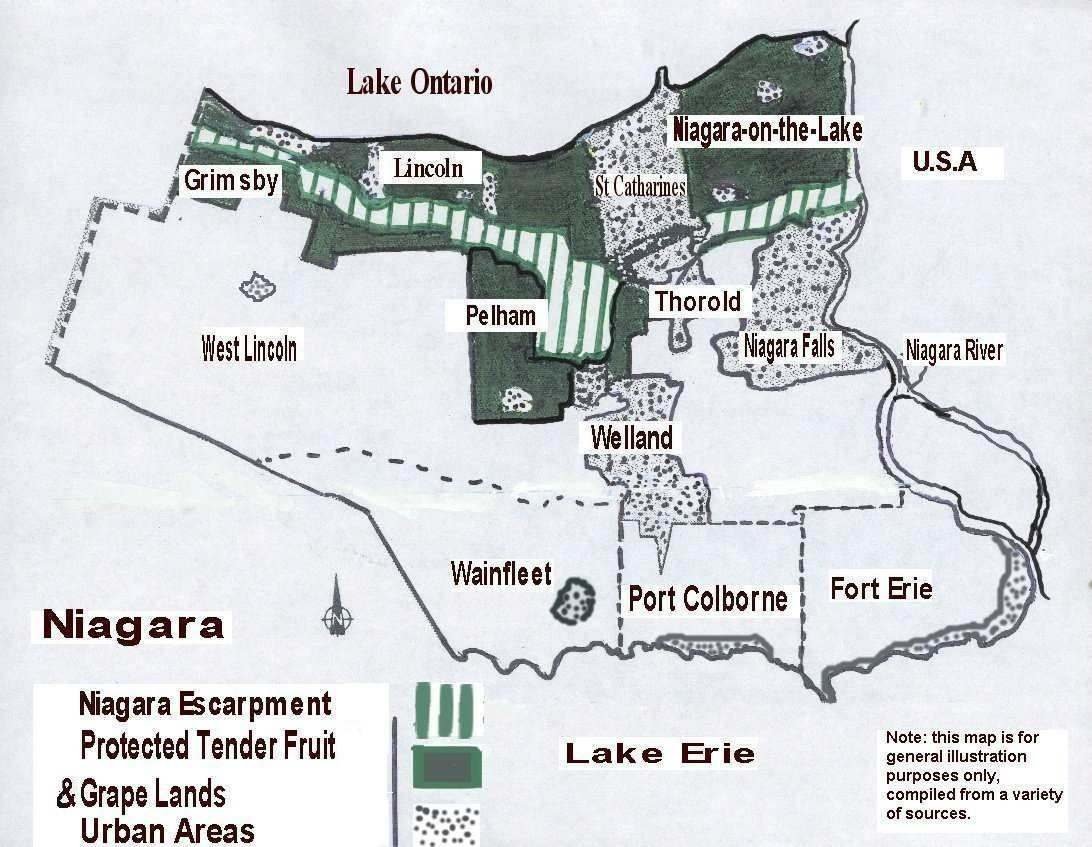

FARM FACTS ABOUT NIAGARA
Geography
* The Niagara Peninsula averages 45 kilometres in width and is situated between Lakes Ontario and Erie. It stretches 60 kilometres between the city of Hamilton and the Niagara River in the Province of Ontario
* There are 232,817 acres of farmland in Niagara and of these only 15,000 acres are suitable for growing tender fruit and 15,000 to 20,000 acres for grapes.
* Tender fruits grow mainly in the sandy soils in north Niagara, near Lake Ontario and the Niagara River, in Grimsby, St. Catharines, Lincoln, Niagara-on-the-Lake and Niagara Falls. They also grow well on the sandy soils of the Fonthill Kame moraine, and surrounding lands in Pelham.
* Tender fruits include cold-sensitive fruits i.e. peaches, apricots, sweet and sour cherries, and plums, and for marketing purposes by the Tender Fruit Marketing Board, pears, which are not as cold - sensitive.
* Grapes grow anywhere that tender fruits do. They also grow well on clay soils below, on and above the Niagara Escarpment, from Grimsby to Niagara Falls and in the "shadow fruitbelt" which runs approximately 2 kilometres south of the Escarpment. .
* Due to Free Trade rules, brought into play in the late 1980 s, many of the native "labrusca" grapes were pulled out eg. Concords and those that remain are used for juice and jellies etc., while the newer French-hybrids and vinifera grapes are used to make award- winning wines. Ice wines are the latest popular wine , as Niagara vintners take advantage of cold winter nights to freeze the grapes on the vine and then produce a very special and popular wine.
* Niagara is located at a latitude of 43 degrees north, which allows for a fairly long summer and an adequate winter chill.
* Niagara has a 150-170 days growing season which is long enough for fruit.
* The average rainfall is between 75 and 100 cm. (30-40 inches) :this is optimal for fruit growing.
* Niagara does not have many extended dry periods which may cause serious crop losses.
* The average summer temperature is between 18 and 21 degrees Celcius (64-70 degrees F.)
* Niagara has an absence of temperature extremes. The summers are cool and dry enough to control disease and pests and sunny enough to produce high quality fruit.
* Hail and storms are much less frequent and severe than they are further south. The inland position of Niagara reduces the possibility of very high winds.
* Tender fruit crops need sandy soils and good natural drainage which are available in Niagara .
* The climate-Escarpment-Lake effect is where air is warmed and cooled through heat exchange with warm land surfaces. In Niagara, heat is stored in Lakes Erie and Ontario and the interaction between the Escarpment and the open waters acts to moderate the temperature on the fruit lands, helping prevent the buds from opening too early in the Spring and pulling the air along to help prevent a pooling of cold air on still nights. For the tender fruit lands of the Fonthill Kame area, the Kame itself sets up air drainage that has the same effect.